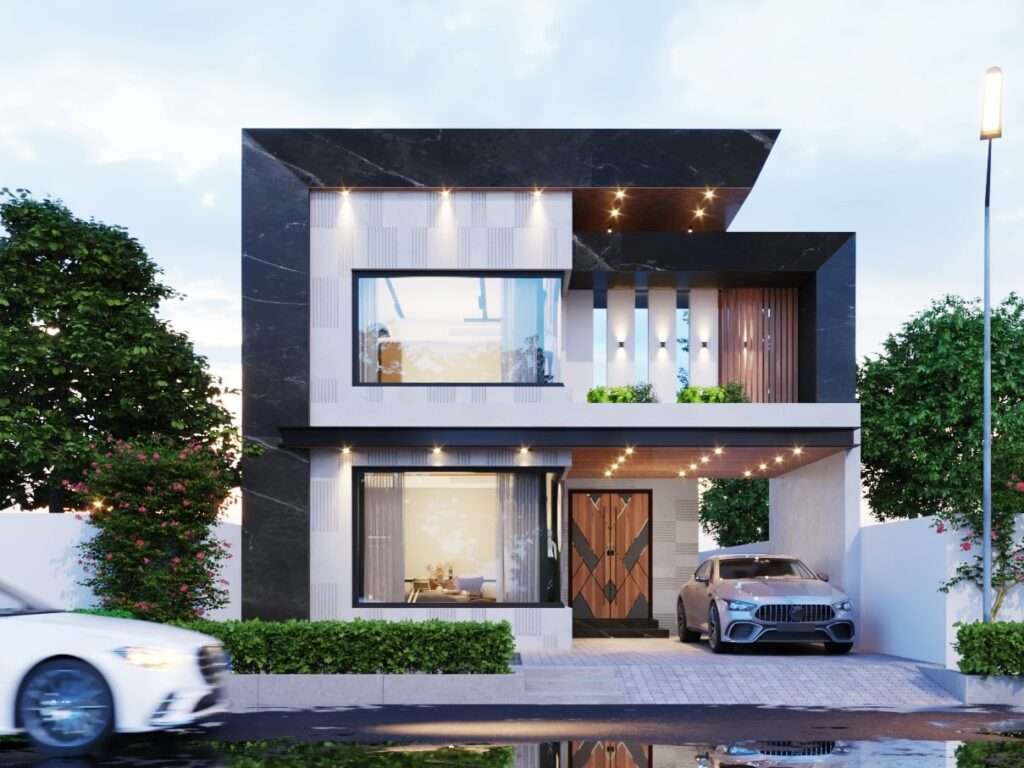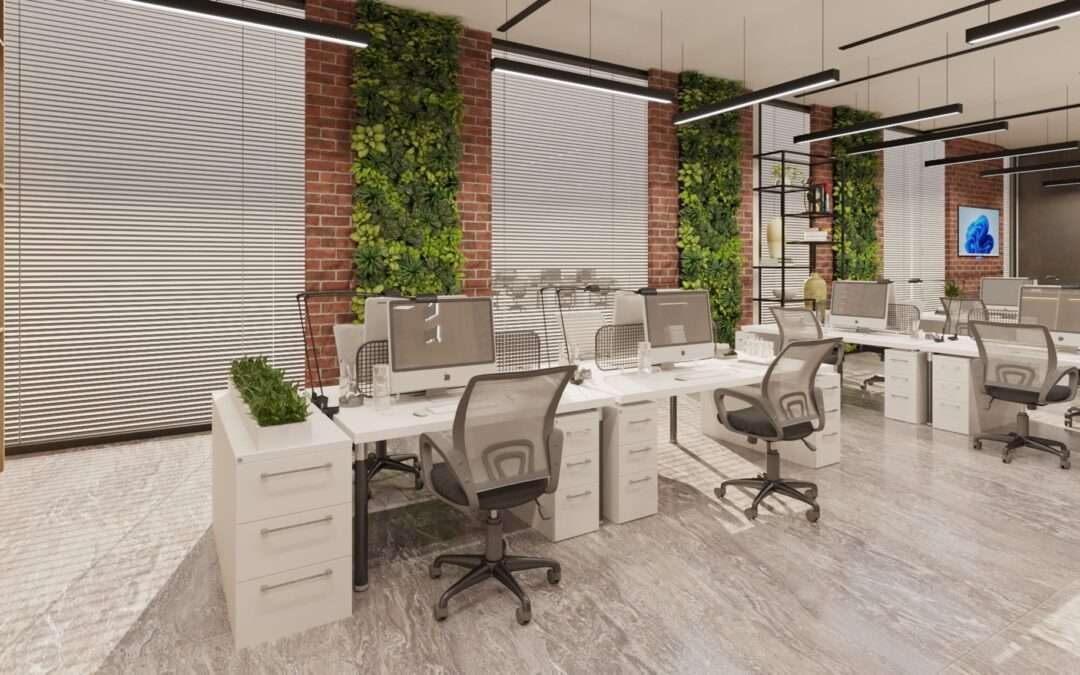Green buildings are a practical solution to help fight climate change. These buildings are designed to reduce environmental impact by focusing on energy efficiency, sustainable materials, and advanced technologies.
How they help:
- Green buildings consume less energy, often using renewable sources, which helps lower carbon emissions.
- They reduce waste through sustainable construction practices and recycling, keeping materials out of landfills.
- Water conservation is another major benefit, with features like low-flow fixtures and rainwater harvesting.
- These buildings also focus on healthier indoor environments, improving air quality and leading to better health outcomes.
- Green buildings are built to withstand extreme weather, making them more resilient to climate change.
Incorporating these features, Green buildings and climate change help reduce greenhouse gases and improve living conditions, making them essential for a sustainable future.
What Is Energy Efficient Architecture?
Energy-efficient architecture is about designing buildings that reduce energy usage while maintaining comfort and functionality. It focuses on creating structures that are environmentally responsible.
Key aspects include:
- Passive design: This approach uses natural light and ventilation to minimize the need for artificial heating and cooling.
- Smart systems: Automated tools such as lighting controls and climate regulation help save energy.
- High-performance materials: Insulation, energy-efficient windows, and roofing materials all contribute to lowering energy consumption.
- Renewable energy: Solar panels, geothermal systems, and wind turbines are increasingly used in energy-efficient buildings.
Energy-efficient architecture reduces energy bills, lowers carbon emissions, and supports a more sustainable future while maintaining comfort.

Key Differences Between Commercial and Residential Architecture
While both types of architecture involve designing and building structures, their goals and requirements are quite different.
In residential architecture:
- The focus is on comfort, personal style, and creating spaces that feel like home.
- Homes are usually smaller in size, with design reflecting individual or regional preferences.
- Privacy, family needs, and creating a cozy atmosphere are key priorities.
Commercial architecture, on the other hand:
- Focuses on functionality, capacity, and meeting specific regulations.
- Designs are often larger, intended for businesses like offices, shopping centers, or hotels.
- Commercial buildings require specialized features like advanced heating and cooling systems, fire safety measures, and accessibility.
These differences help architects choose the right approach for each building type, ensuring it serves its intended purpose.
Key Benefits of Working with Commercial Architects
Hiring a commercial architect goes beyond getting floor plans. They bring expertise and creativity to help bring your business vision to life.
Some of the main benefits include:
- Navigating regulations: Commercial architects are experienced in zoning laws, permits, and building codes, helping you avoid legal issues.
- Space optimization: They design layouts that maximize available space, improving customer experience and employee productivity.
- Brand alignment: A well-thought-out design reflects your company’s identity and values, strengthening your brand.
- Sustainable design: Many commercial architects integrate eco-friendly solutions that minimize the building’s environmental impact.
- Cost savings: Smart design choices lead to long-term savings in energy bills and maintenance.
Best architectural services can turn your ideas into a functional, inspiring, and efficient space.
Key Things to Consider in the Design of Educational Buildings
Educational buildings play a significant role in learning. A well-designed school or university can inspire creativity, improve focus, and foster collaboration.
Important factors to consider include:
- Flexible spaces: Classrooms and common areas that can adapt to different teaching styles and activities.
- Natural light: It enhances concentration, improves mood, and reduces stress, making it essential for a healthy learning environment.
- Technology integration: Smart classrooms with digital boards, Wi-Fi access, and charging stations are essential.
- Safety and accessibility: Ensuring the building meets accessibility standards and provides secure entry points is crucial.
- Sustainability: Features like solar panels, rainwater harvesting, and green roofs not only help the environment but also teach students about sustainability.
Designing educational buildings with these elements ensures they support both educational goals and the future of the students.

Trends in Modern Hospitality Architecture for 2025
The hospitality industry is quickly changing, and so is its green buildings architecture and climate change. By 2025, hotels and resorts are focusing more on creating unforgettable experiences, sustainability, and integrating advanced technology.
Key trends include:
- Biophilic design: Incorporating nature into building designs with green walls, natural materials, and large windows offering outdoor views.
- Smart hotel rooms: Technology is making stays more convenient with voice-activated controls, mobile check-ins, and energy-saving features.
- Cultural integration: Reflecting local art, history, and traditions in the design, enhancing the guest experience.
- Modular construction: This method makes building faster, more cost-effective, and environmentally friendly.
- Sustainability: Hotels and resorts are increasingly pursuing green certifications and using eco-friendly materials to reduce environmental impact.
The future of hospitality architecture focuses on creating unique, sustainable, and tech-savvy experiences for guests.
How Residential Interior Design Is Changing for the Better
Residential interior design is moving away from extravagant decor to creating intentional, functional spaces that improve well-being. Homeowners now prioritize comfort, sustainability, and a healthy environment.
Key trends include:
- Eco-friendly materials: Bamboo, cork, reclaimed wood, and non-toxic paints are gaining popularity.
- Multipurpose furniture: Space-saving, adaptable furniture is perfect for remote work and hosting guests.
- Minimalist design: Simplified interiors reduce clutter, create calm, and help build peaceful living spaces.
- Nature-inspired designs: Earthy tones, natural light, and plants bring the outdoors inside.
- Smart homes: More homes are equipped with automated systems to control lighting, temperature, and security for convenience.
The future of interior design emphasizes creating spaces that are practical, comfortable, and beneficial for well-being.
How Technology is shaping the Future of Home Design
Technology is revolutionizing the way we design and live in our homes, offering new possibilities that were once unimaginable. From the construction of homes to the everyday conveniences they offer, these advances are changing how we live.
Some of the key innovations making a significant impact include:
– Smart technology: Features like voice-controlled lighting, appliances, and security systems help make homes more efficient, intuitive, and comfortable.
– 3D printing: Homes can now be built faster and more cost-effectively, reducing waste during the construction process.
– Energy monitoring: Apps allow homeowners to track their energy and water consumption, making it easier to reduce waste and save resources.
– Augmented reality: Homeowners can visualize and adjust layouts, furniture placement, and designs using AR before making final decisions.
– Net-zero homes: These homes are designed to be completely sustainable, producing as much energy as they use, which helps minimize their environmental impact.
Technology is not only making homes smarter but also enhancing energy efficiency and sustainability in ways that will benefit future generations.

Sustainable Urban Development: Building Cities for the Future
As cities continue to grow, sustainable urban development is becoming a critical focus. The goal is to create environments that are livable today and will thrive for years to come while addressing environmental, economic, and social needs.
Here are some of the strategies shaping the cities of tomorrow:
– Transit-oriented design: Cities are prioritizing walkability and access to public transportation to reduce the need for cars, minimizing traffic congestion and pollution.
– Mixed-use neighborhoods: By combining residential, commercial, and recreational spaces, cities promote convenience, reduce commute times, and foster a stronger sense of community.
– Green spaces: Urban parks, green roofs, and nature corridors are essential in creating breathable, healthy spaces within the concrete jungle.
– Affordable housing: Designing inclusive housing solutions ensures that as cities grow, all residents have access to safe and affordable places to live.
– Circular economy principles: Recycling, local farming, and resource efficiency are emphasized to reduce waste and lower the city’s overall carbon footprint.
Sustainable urban development is key to building cities that can thrive in the face of climate challenges, ensuring they are resilient, inclusive, and environmentally conscious for generations to come.

